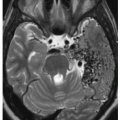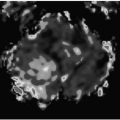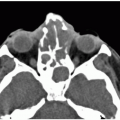Medications in Neuroradiology
MEDICATIONS FOR CONTRAST MEDIA REACTIONS
1. Diphenhydramine (Benadryl)
This antihistaminic produces relief of minor allergic reactions but induces drowsiness and anticholinergic effects (therefore, do not use in cases of glaucoma and prostatic hypertrophy). Parenteral (IV/IM) dose:
Child: 1.25 mg/kg
Adult: 25 to 50 mg
Oral dose:
Child: 1.25 mg/kg q4-6h
Adult: 25 to 50 mg q4-6h
2. Epinephrine
This alpha and beta receptor agonist induces vasoconstriction and increased peripheral vascular resistance, increases cardiac output, relaxes bronchi, inhibits histamine release, and relieves pulmonary edema. Do not use in cases of preexisting beta blockade.
Dose for mild to moderate reactions:
Concentration: 1:1,000
Route: SQ/IM
Volume:
Child: 0.1 to 0.3 mL/kg (<0.5 mL total)
Adult: 0.3 to 0.5 mL
Repeat:
Child: q30min
Adult: q15min
Dose for severe reactions:
Concentration: 1:10,000
Route: IV over 5 minutes
Volume:
Child: 1 to 3 mL
Adult: 3 to 5 mL
Repeat:
Child: q30min
Adult: q15min
3. Aminophylline
Increases cAMP, leading to bronchial muscle relaxation, CNS stimulation, and cardiovascular effects.
May produce hypotension and seizures.
Dose for acute bronchospasm:
5 to 6 mg/kg IV slowly
4. Dexamethasone sodium phosphate
This corticosteroid is easier to use in an emergency and has the fastest effect. Inhibits production of allergic mediators.
Dose for acute reaction:
20 mg IV q2-6 h PRN
5. Atropine
Produces anticholinergic effects, thereby inhibiting vagal tone, and is useful for bradycardia accompanied by hypotension.
Dose for acute reactions:
Child: 0.2 mg/kg IV (<0.6 mg total)
Adult: 0.5 to 1 mg IV q5-10min (<2 mg total)
6. Diazepam (Valium)
This GABA agonist inhibits neuronal firing and may be used to control seizures. It may be cardiotoxic and cause respiratory depression.
Dose in acute situation:
Child: 0.2 to 0.5 mg/kg IV q20-30min for a maximum of two doses
Adult: 5 to 10 mg IV q20-30min
7. Other medications, such as naloxone (Narcan), lidocaine, nitroprusside, phentolamine, ranitidine, and sodium bicarbonate, are used less often in cases of contrast media reaction and require more experience. Consult with the nurse and/or anesthesiologist for correct use.
ENDOTRACHEAL TUBES
|
PREVENTION OF CONTRAST REACTIONS IN ALLERGIC PATIENTS
Prednisone, 50 mg PO q6h for three doses starting the day before (13, 7, and 1 hour prior to procedure) the procedure, or
Methylprednisolone, 32 mg PO 6 to 24 hours before, and then repeat dose 2 hours before procedure.
Diphenhydramine (Phenergan), 50 mg PO or IV I hour before procedure.
MANAGEMENT OF CONTRAST REACTIONS
FACIAL OR LARYNGEAL EDEMA
1. Give O2 6 to 10 L/min (via mask).
2. Give alpha agonist (arteriolar and venous constriction): epinephrine SC or IM (1:1,000) 0.1 to 0.3 mL (= 0.1 to 0.3 mg) or, especially if hypotension evident, epinephrine (1:10,000) IV 1 to 3 mL (= 0.1 to 0.3 mg) slowly. Repeat as needed up to a maximum of 1 mg.
If the patient is not responsive to therapy or if there is obvious acute laryngeal edema, seek appropriate assistance (e.g., cardiopulmonary arrest response team).
BRONCHOSPASM
1. Give oxygen 6 to 10 L/min (via mask). Monitor: electrocardiogram, oxygen saturation (pulse oximeter), and blood pressure.
2. Give beta-agonist inhalers (bronchiolar dilators, such as metaproterenol [Alupent], terbutaline [Brethaire], or albuterol [Proventil or Ventolin]) 2 to 3 puffs; repeat as necessary. If unresponsive to inhalers, use SC, IM, or IV epinephrine.
3. Give 1 dose of EpiPen/epinephrine SC or IM (1:1,000) 0.1 to 0.3 mL (=0.1 to 0.3 mg) or, especially if hypotension evident, epinephrine (1:10,000) IV 1 to 3 mL (=0.1 to 0.3 mg) slowly. Repeat as needed up to a maximum of 1 mg.
Call for assistance (e.g., cardiopulmonary arrest response team) for severe bronchospasm or if oxygen saturation <88% persists.
HYPOTENSION WITH TACHYCARDIA (ANAPHYLAXIS)
1. Legs elevated 60 degrees or more (preferred) or Trendelenburg position.
2. Monitor electrocardiogram, pulse oximeter, blood pressure.
3. Give oxygen 6 to 10 L/min (via mask).
4. Rapid intravenous administration of large volumes of Ringer lactate or normal saline.
If poorly responsive: epinephrine (1:10,000) IV 1 mL (=0.1 mg) slowly Repeat as needed up to a maximum of 1 mg. If still poorly responsive, seek appropriate assistance (e.g., cardiopulmonary arrest response team).
HYPOTENSION WITH BRADYCARDIA (VAGAL REACTION)
1. Remove offending stimulus.
2. Secure airway: give oxygen 6 to 10 L/min (via mask).
3. Monitor vital signs.
4. Legs elevated 60 degrees or more (preferred) or Trendelenburg position.
5. Secure IV access: rapid administration of Ringer lactate or normal saline.
6. Give atropine 0.5 IV slowly if patient does not respond quickly to steps 2 to 4.
7. Repeat atropine up to a total dose of 0.04 mg/kg (up to 4 doses in an adult).
8. Ensure complete resolution of hypotension and bradycardia prior to discharge.
HYPERTENSION, SEVERE
1. Give oxygen 6 to 10 L/min (via mask).
2. Monitor electrocardiogram, pulse oximeter, blood pressure.
3. Give nitroglycerin 0.4 mg tablet, sublingual (may repeat × 3); or, topical 2% ointment, apply 1 inch strip.
4. If there is no response, consider labetalol 20 mg IV, then 20 to 80 mg IV every 10 minutes up to 300 mg.
5. Transfer to the intensive care unit or emergency department.
6. For pheochromocytoma: phentolamine 5 mg IV (may use labetalol if phentolamine is not available)
SEIZURES
1. Give oxygen 6 to 10 L/min (via mask).
2. Consider diazepam (Valium) 5 mg IV (or more, as appropriate) or midazolam (Versed) 0.5 to 1 mg IV
3. If longer effect is needed, obtain consultation; consider phenytoin (Dilantin) infusion—15 to 18 mg/kg at 50 mg/min.
4. Careful monitoring of vital signs is required, particularly of pO2 because of risk of respiratory depression with benzodiazepine administration.
5. Consider using cardiopulmonary arrest response team for intubation if needed.
PULMONARY EDEMA
1. Give oxygen 6 to 10 L/min (via mask).
2. Elevate the torso.
3. Give diuretics: furosemide (Lasix) 20 to 40 mg IV, slow push.
4. Consider giving morphine (1 to 3 mg IV).
5. Transfer to the intensive care unit or emergency department.
URTICARIA
1. Discontinue injection if not completed.
2. No treatment is needed in most cases.
3. Give H1-receptor blocker: diphenhydramine (Benadryl) PO/IM/IV 25 to 50 mg.
If severe or widely disseminated, give alpha agonist epinephrine SC (1:1,000) 0.1 to 0.3 mL (= 0.1 to 0.3 mg) (if no cardiac contraindications). (Source: ACR Manual on Contrast Media http://www.acr.org/SecondaryMainMenuCategories/quality_safety/contrast_manual.aspx.)
Stay updated, free articles. Join our Telegram channel

Full access? Get Clinical Tree







